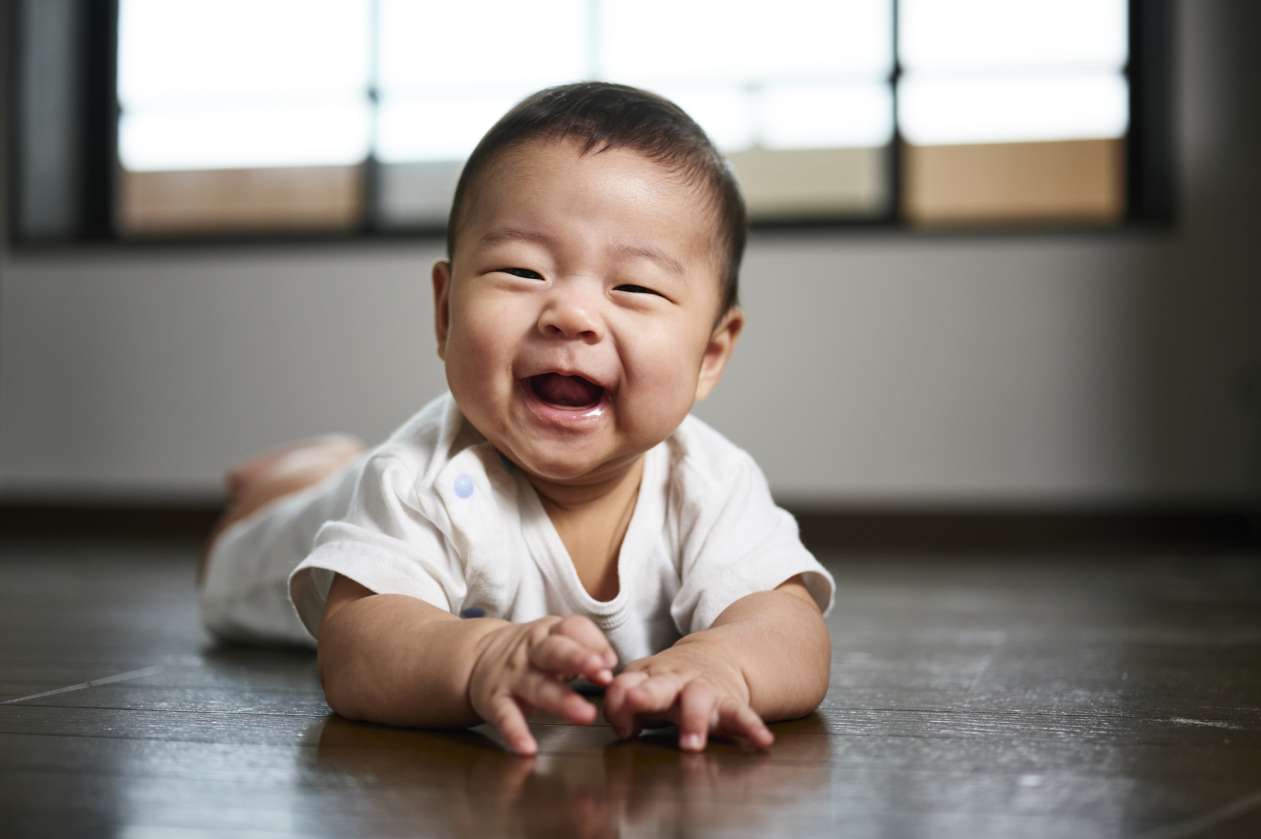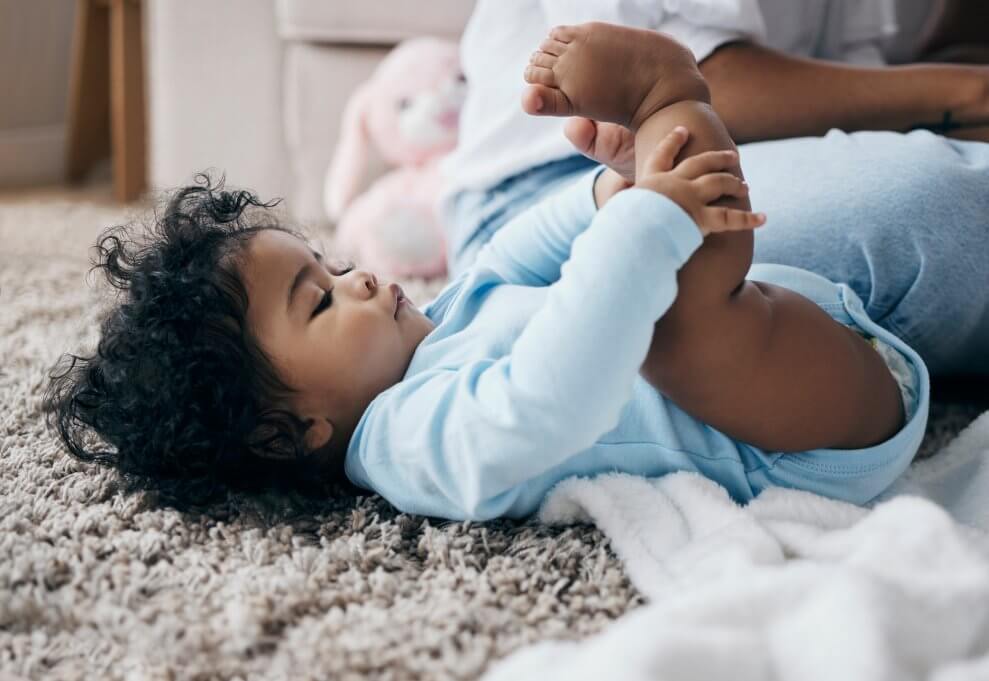
Why babies need the freedom to move + floor activities for each stage
As a first-time mom, I wanted all the things for my new baby. Crib, change table, cute outfits—check! Swinging chair, bouncer, play mat, jumper, and Exersaucer—check! As you might imagine, it didn’t take long for my small living room to be overtaken by activity centres. To my surprise, however, my little one wasn’t interested in any of them. As soon as he could wiggle and roll, his favourite place was on the ground.
By the time my fifth baby came along, all those activity centres that had once crowded my living room had been passed along, replaced with a large foam mat where my new baby could roll, sit, crawl, cruise, and eventually walk. In this article, I’m going to share with you why babies need to move their bodies freely and share age-appropriate activity ideas that will get your baby moving freely without any fancy gear.
Babies like to move it, move it
Unlike other animals, newborn humans aren’t very mobile. They can’t crawl or run, aren’t very coordinated, and can’t see well. Of course, these limitations are very normal and probably a good thing. I don’t know about you, but the idea of running after a newborn seems frightening. However, it doesn’t take long for those wee babies to start showing an interest in moving their bodies.
According to the Canadian Paediatric Society, by the end of the first three months, babies start to roll from front to back, lift their head and chest when on their belly, and stretch and kick their legs. By the end of 12 months, those same babies can sit on their own, crawl and scoot, pull to standing, cruise along furniture, and possibly even be walking! If you’re looking for more information on milestones, this article on the CDC’s revised developmental milestones will help.
Babies are wired to move. It’s how they learn and develop all those important motor skills. However, these days, babies are often tucked into car seats, strapped into strollers, and restrained in high chairs. Sometimes babies need to be restrained for their safety, but being restrained too much can slow motor development and even lead to health issues. The Canadian 24-Hour Movement Guidelines for the Early Years recommend that babies less than a year old should be physically active several times a day, the more the better, in a variety of ways—and that babies shouldn’t be restrained for more than one hour at a time.
To get your baby play started, lay a mat or blanket on the floor in a safe space, indoors or outdoors, and try out some of these simple age-appropriate movement activities together.

Baby activities for 0 to 3 months
At this stage, babies aren’t very mobile, but they are still developing important motor skills. For the first three months, babies are building head and neck control, hand coordination, and leg strength.
Tummy time!
To help babies develop early movement skills, the Canadian 24-Hour Movement Guidelines for the Early Years suggests babies get at least 30 minutes of tummy time spread throughout the day while awake. Start with short periods of time, about three to five minutes, and work up to an hour of tummy time a day by three months of age. Tummy time on the floor is great, but laying your baby on your own tummy or across your knees works well too. For more tummy time tips and ideas, read 7 steps to get your infant ready for tummy time.
Baby “sit-ups”
Babies won’t be sitting on their own until closer to six months, but helping your baby to sit up will help strengthen those abdominal muscles. Place your baby on the floor and use your hand to support her shoulders, neck, and head. Gently bring her into a sitting position and then lay back down again. That’s a baby sit-up!
Roll over, roll over
Around three months, babies start to roll from their belly to back. To encourage your baby to practice this skill, place a toy just out of reach. When the baby tries to reach for the toy, he will shift his weight and possibly roll over. Another option is to shake a rattle to get your baby’s attention and then move the rattle to one side. This gets your baby’s head moving, which can initiate a roll-over.

Baby activities for 4 to 6 months
From 4 to 6 months old, babies are gaining more control of their hands, feet, arms, and legs. At this age, babies start to reach for objects, play with their feet, sit with support, scoot, and roll over. Here are some easy activities you can do together.
Baby push-ups
You might notice that your baby is pushing her chest off the ground during tummy time. This is a baby push-up and important for crawling. Help your baby practice those baby push-ups by holding a hand mirror or toy just above your baby’s eyes so he has to look up to see it. When your baby initiates pushups, cheer him on!
Baby in the middle
Babies don’t typically start crawling until closer to nine months, but between 4 to 6 months old you might notice your baby creeping, pushing, rolling, and scooting around. These movements are preparing your baby to crawl. To encourage your baby to wiggle and move, play baby in the middle! Lay your baby on the floor, tummy down, and place a variety of baby-safe objects or toys around her to discover. Encourage her to reach, roll, and scoot to grasp the objects around her and celebrate her wins.
Prop sitting
Most 6 month old babies can sit on their own for a bit. To help babies activate muscles for sitting, more tummy time is key (see tummy time in movement activities for 0 to 3 months). Another activity is to practice prop sitting. For this activity, have your baby sit on a mat and “prop” them up with her arm and hand placed in front of her on the floor. If babies are just learning to sit, stay close by as babies can get tired of this position quickly. Like tummy time, practice prop sitting a few minutes a day and increase over time as your baby gets stronger.

Baby activities for 7 to 9 months
From 7 to 9 months, babies are becoming much stronger and more coordinated. They start to sit, crawl around, stand, and cruise along furniture.
Moving mountains
Get your baby moving and exploring a mountain of pillows. Place a few pillows on the ground to allow your baby to climb them. Crawling over an uneven surface allows your baby to experience different ways to move her body while exploring something new.
Texture crawl
Learning to crawl is hard work. Sometimes changing up the surface a baby is crawling on can motivate babies to explore and move more. A texture crawl is a perfect way to do that. This can be done indoors or outdoors. To set up a texture crawl indoors, place a few items with different textures on the ground (silk scarves, rug, towel, fluffy throw). To do a texture crawl outdoors, explore different areas that are safe for your baby to crawl (on a lawn, in a play park) that have different textures.
Rise up!
By 7 months, babies should be able to hold their own weight while standing and might even start to pull themselves up on furniture. To play rise up, start with your baby sitting on a mat and hold her hand. Gently lift her up until she’s standing. Encourage her to stand for a few seconds before lowering your baby gently back down to sitting.

Baby activities for 10 to 12 months
Babies between 10 to 12 months are in motion. At this age, they are usually crawling, standing, and cruising along furniture. By 12 months, your baby might even start taking his first steps! Here are some play ideas to encourage the development of gross motor skills for this age range.
Ball chase
Chasing a ball on the ground encourages babies to crawl, cruise, and eventually walk. A soft or textured ball works great for this activity, but any ball will work. Of course, your baby will love this activity even more when you participate, so get ready, set, go!
Stand and reach
While your baby holds onto a soft piece of furniture, place a toy to one side, just out of reach. Babies will typically shift their weight towards the toy to grab it, a similar action needed for walking. If your baby is already cruising along furniture, place the baby toys further away to get him moving. Eventually, when your baby can stand independently, you can use this same activity to encourage her to take that first step.
Wiggle and bop
Babies love music. They are born to wiggle and bop to their favourite tunes. Put on some tunes, help your baby into standing position, either by holding soft furniture or holding his hands, and bop up and down and wiggle to music. This playtime activity gets those little legs stronger and ready for walking.
Wrapping it up
I hope you and your baby have fun moving together at home and outside. Did I miss your favourite floor activity for babies? Feel free to share it below!





